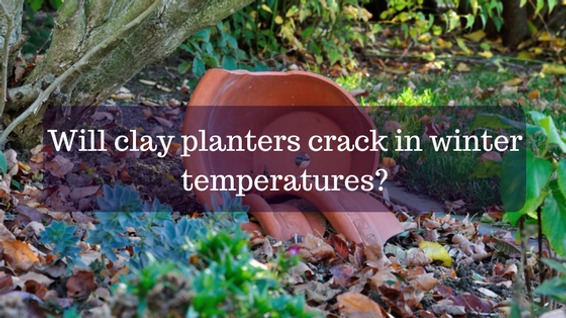Yes, clay pots can crack during the winter. As water freezes, it expands causing fissures and cracks in your pots. It’s the same thing that causes potholes to form in the road. Though it can happen to just about any material, the most susceptible pots are those made of terra cotta and clay. In fact, the very thing that makes theses pots ideal for container gardening also puts them at extra risk of freezing.
Clay and terra cotta are extremely absorbent materials, soaking up water like the proverbial sponge. This is a great characteristic for a flower pot to have. It helps regulate soil moisture and prevents soggy conditions which can damage plants’ roots. But during the winter, this advantage turns into a liability. The pot will absorb moisture from left over potting soil, rain, snow or frost that can then freeze, creating cracks or even causing breakage.
Ideally, clay and terra cotta pots should be emptied of their old soil (you can add this to your compost pile), cleaned up (with a solution of 1 part bleach to 10 parts water) and stored indoors during the winter. But this is not always practical. Not all of us have enough space in the garage or shed and many pots are just too heavy to move very far, if at all. If you need to leave your pots outdoors during the winter, there are some things you can do to protect them against freezing.
Small Containers
Small pots are the easiest to bring indoors. An unheated garage, garden shed or greenhouse is ideal. But if you don’t have the room, you can stack your pots up along the house under the eaves. Don’t “nest” the pots together, but stagger them to promote air circulation and keep them dry.
Medium Containers
Containers that are too big to move around can be tipped upside down. This will prevent water from pooling in the bottom and freezing. Elevate the lip of the pot off the ground with small bricks, rocks, pieces of wood or ceramic pot feet. If the pot touches the wet ground, it can freeze to it and break apart when you try to move it in the spring.
Large Containers
For containers too big to be moved at all, you can also cover with a waterproof tarp to keep the moisture out. Many gardeners like to wrap large pots, or those that will remained planted during the winter, with bubble wrap to help insulate them.
Of course, when dealing with Mother Nature, nothing is guaranteed. But these measures will help protect your pots during the winter so you can enjoy them for years to come.

